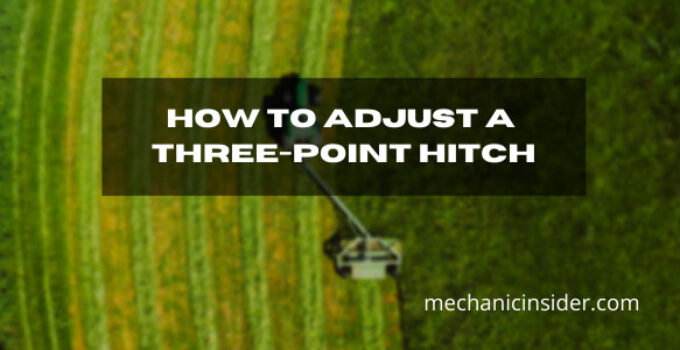A hitch is one of agricultural technology’s most advanced connectors that attach equipment to tractors. It plays a vital role in the day-to-day life of farmers while they work in the field. But sometimes, it gets displaced from its original adjustment, and you need to fix it right away. So, do you know how to adjust a three-point hitch?
You need to adjust the top link as well as the stabilizer first. Top link adjustment is a little difficult for its screws. Then pull the pin to connect the stabilizer. After that, you can begin with implementation. You should also turn the turnbuckles, loose the screw, and tighten the screw using a wrench.
Three-point hitches improved a farmer’s tractor’s performance and provided a greater return. They also made carrying or lifting bulky goods easy.
Basics of Adjusting Three Point Hitches
The majority of tractor-related questions concern how to connect a three-point hitch to a tractor. However, before adjusting a three-point hitch, you must first grasp the fundamentals.
Here are some facts to think about:
You must have sufficient knowledge of the components of a three-point hitch and where to connect it. How can you adjust it when you don’t know anything about your John Deere 3-point hitch controls?
There isn’t much necessary down pressure while cutting the lawn or something like that. So, in that scenario, the top link with the top adjustment hole will be the ideal option for you.
If you require tremendous down pressure for the post-hole digger or the box blade, you can install a bottom link.
It would help if you kept in mind the implementation angle.
When Do You Need to Adjust A Three-Point Hitch?
If you own a John Deere or Kubota tractor, you should be aware of the Kubota 3-point hitch height adjustment. The flexibility to change the raising arms on Kubota tractors is one of their best features, and it allows us to look up different implements quickly.
This specialty hitch for connecting tools to tractors has three attachment points, providing a secure means to enhance a tractor’s capabilities. Getting the vehicle and equipment into the correct spot can take some work.
If you wish to haul a hefty load, you’ll need to adjust the three-point hitch on your John Deere.
Steps To Adjust A Three-Point Hitch
Three-point connections are now standard equipment on most tractors. If you plan to go farming, you need to learn how to adjust a three-point hitch to tractors. Here are the easy steps of the procedure:
Adjusting Top Link
There are many questions about how to adjust the top link on a 3-point hitch, although with the self-explanatory screw piece because the three holes are a little complicated.
There are some easy methods for three-point hitch top link adjustment. The three slots all have to do with pressure and use that leverage directly on the tractor’s rear.
The hole at the top is less dangerous, and it serves as a type of hinge for the top link. So it will not go higher or down but will remain in the same place.
On the other hand, the bottom link can shift and remain in the box blade’s ideal situation. The box blade is ready to come down with a rising tilt because the connection point is lower in the rear.
Adjusting Stabilizer
A three-point hitch stabilizer may need to be adjusted in some circumstances. The modification is required to prevent the tool from swinging excessively.
You must pull the pin to connect it and position the item in the proper location for swinging to occur. Turnbuckle stabilizers are also quite visible these days.
You’ll have to start with the implementation. So, it can swing back and forth while remaining in the air.
The next step is to decide where you want to put the tool. Usually, everyone would choose the tractor rearward as the preferred option in this situation.
Then, begin to turn the turnbuckles. You have to ensure that each is precisely at your designated spot along with installation. Those must also be sufficiently tight.
After that, you must loosen a jam nut to place the implement precisely at which it feels tight enough to avoid any back and forth swinging movement.
Tighten the jam after moving them downwards. That should be the end of the swinging implementation issue.
You can reverse the operation to remove the component and release the jam nut to allow lower link arms to wrap around pins. Lastly, turn it off.
Adjusting three-point hitch height is also important because it comprises a hydraulic up-down and a top link bar. The top link bar is a threaded turnbuckle that allows you to fine-tune or enhance up or down movement by twisting the middle component.
How Can You Make a Three-Point Hitch Easy To Use?
Before using a three-point hitch, you must first understand how a three-point hitch is explained. There are some alternatives for making using a 3-point hitch convenient.
Using Category 1 three-point hitch
The conventional 3-point hitch features two stiff lift arms having draft links at the ends. Upon that implementation, you must align the draft link holes with the lifting arm pins.
Then, manually guide the draft links onto the pins. Lynch screws attach the implement through the lifting arm pins. The top link is then fixed and connected, and it’s ready to use.
A standard Category 1 three-point hitch is available on the John Deere 3043D Compact Utility Tractor (US CA).
Using Telescoping Draft Links on a Three-Point Hitch
You have a little more flexibility with a three-point hitch with telescoping draft connections. Reverse the tractor to line up the draft line ports with the equipment lifting arm pins.
When using telescoping draft links, detach the lockout pin from the three-point hitch stabilizer bar. After that, open the telescoping function, and stretch the draft links to the implements. It makes the hookup operation much more uncomplicated.
After that, place the linchpins, replace the lock pin in the stabilizer bar, and attach the top link.
Using a Quick Hitch
You must concentrate on the upper hook on the quick hitch when backing up towards the instrument and using a quick hitch. Everything else will work out perfectly as the bottom screws align with the lift arm screw bearings.
To hold the implement in position, elevate it and lock the locking handles after it is linked. It doesn’t get any easier or quicker than that for a three-point hookup as it is the simplest method.
Common Problems with Three-Point Hitches & How To Solve
Three-point hitches have some frequent problems that people experience. If you understand how three-point hitches work, you can quickly identify the problem.
People frequently ask us what is necessary to fix a tractor’s three-point hitch, and we’ll talk about the issues and possible solutions here.
Three-Point is up and will not go down
“Why won’t my three-point hitch go down?” is the typical query about three-point hitch problems. In such cases, the most common problem is that the hydraulic flow speed control valve is blocked between your knees under the seat.
Examine this control valve and ensure that it is entirely open. Verify all the connections between the valves and ensure the handle is secured and moves quickly if the valve is open.
If everything appears to be in order, the following procedure is to inspect the speed control valve properly.
Three-point leaks down
Try lifting the three-point arm links together to the top and closing the specific three-point speed control valve. It is typically placed behind the tractor driver seat if the three-point hitch leaks down by itself.
Lock the tractor’s speed control valve to the stop position. Then drag the tree point control lever. Attempt to elevate the arms using your hands.
Three-Point drifts down
When a tractor 3-point hitch fails to function correctly, the probable causes are insufficient fluid, a blocked hydraulic filter, and insufficient or polluted hydraulic fluid.
Most tractor operations, including the 3-point hitch, are powered by the hydraulic system, hydraulic filter, and fluid maintenance. These are essential to each tractor’s operation. So, you need to fix the issue right away.
Here are some easy steps you can follow:
Step 1: The very first stage is to identify whether the whole hydraulic system is functioning correctly or not.
When a load is mounted on the tractor, check it to see if it is still operational. It will figure out any problems with the pump. If the load does not work correctly, the problem is probably related to the hydraulic pump.
Step 2: Disconnect and reconnect the hydraulic pump’s primary pressure and return connections unless your tractor does not have a loader.
Launch the tractor and drive it for no more than 5 seconds. The pump can be checked out if the engine drags or refuses to start or the loader usually operates.
Step 3: The next step is to inspect the three-point control handle to ensure no rods or holding pins have fallen out. If those are correct, there is a mechanical part failure inside the 3-point housing, which will necessitate tractor rear-end removal.
Bottom line
The three-point tractor hitch has revolutionized farming in various ways. You’ll have to learn how to operate and set your 3-point hitch appropriately to fully utilize your tractor’s potential. But the problem is when something goes wrong with adjustments of the hitch, and you don’t know the fixing methods. Three point sprayer also works smoothly if adjusted accurately.
Hopefully, this section on how to adjust a three-point hitch has made every effort to comprehend on a tractor. You can follow our guidelines to try that yourself. Good luck with your farming!



